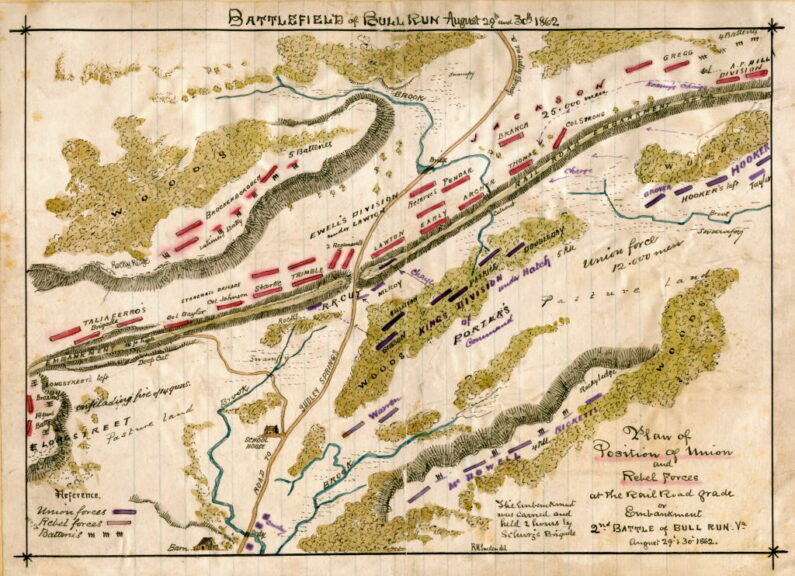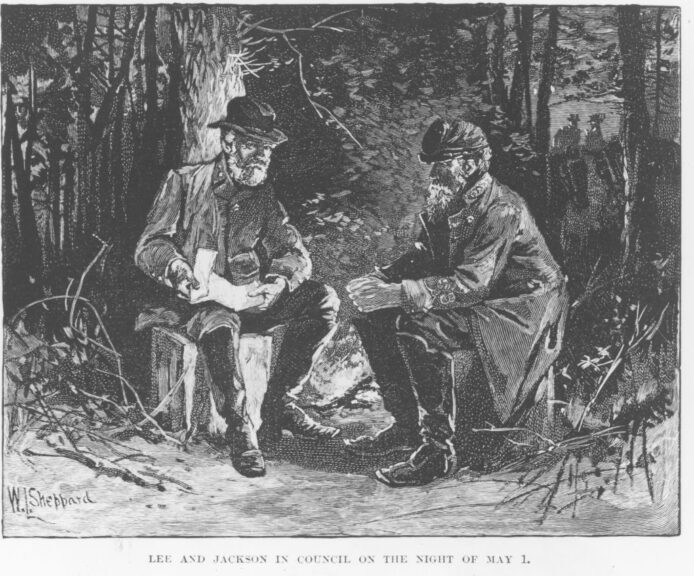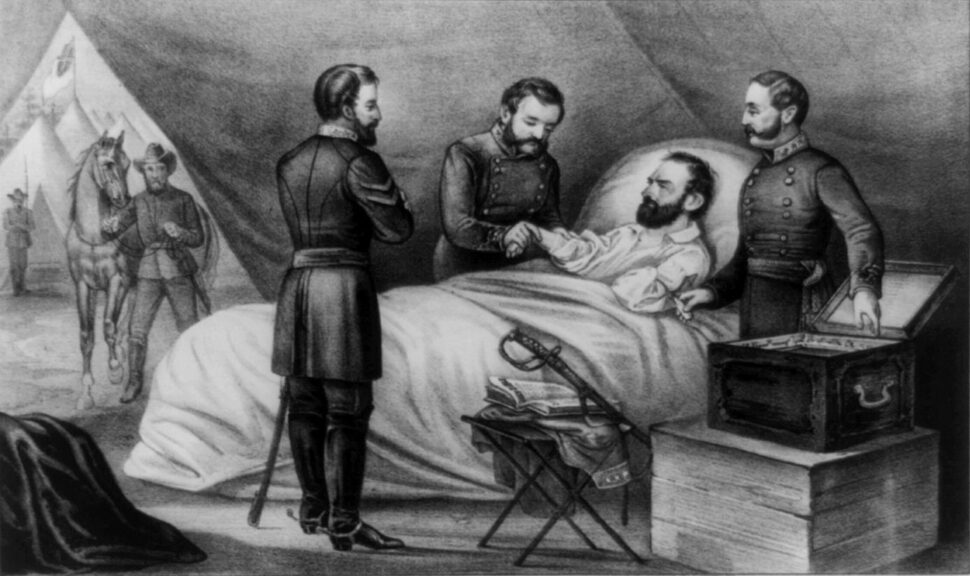Over the years, the United States has produced many remarkable generals and admirals, but only a few have stood out as world-class strategists and leaders of troops. As Veterans Day approaches on November 11, let’s remember and celebrate them. Here is my list of America’s finest 11 commanders.
This series is about military prowess and those who excelled on the battlefield. The inclusion of any Confederates in this list should not be misconstrued as in any way supporting the cause of the self-described Slave-Holding Confederacy itself for which such men fought. The preservation of the monstrous injustice of slavery in North America and the stated goal of the seceding states had to be destroyed. But this does not diminish the achievements of certain Southern generals on the field of battle, which is solely what this series seeks to examine.
Thomas J. “Stonewall” Jackson, 1824 – 1863 (Civil War)
Once again, I risk incurring the wrath of all good Union men and women when I include a Confederate on my list. But how can I not? Like Lee, the West Pointer and Virginia Military Institute (VMI) artillery instructor Thomas Jackson initially opposed secession, but when his home state of Virginia seceded, he opted to serve the Confederacy. His reputation and nickname “Stonewall” was forged on the river of gore at First Bull Run. During the height of the fighting, when the rebel lines began to waver, Jackson’s men held firm. Rebel Gen. Bernard E. Bee exhorted his own men by calling out, “There stands Jackson, like a stone wall!” And thus the legendary sobriquet was born.

circa 1850: Thomas Jonathan Jackson (1824 – 1863), better known as Stonewall Jackson, a Confederate general during the American Civil War. Original Artist: By Desmaisons. (Photo by Hulton Archive/Getty Images)
Although his sterling conduct in the first battle of the war earned him praise from a grateful South, it was Jackson’s brilliant Shenandoah Valley Campaign in the spring of 1862 that demonstrated just how formidable a military man the Bible-thumping, lemon-eating, eccentric Stonewall could be. The valley was a lifeline for the South, a vital corridor of provisions as well as a natural Union invasion route. As such, he was tasked with keeping the area out of Northern control. Husbanding his strength, the stern disciplinarian marched his men up and down the valley at such a grueling pace over such vast distances they were called “Jackson’s Foot Cavalry.”
To his enemies’ chagrin, his small army would suddenly appear miles away from where his baffled Union adversaries would expect and inflict one punishing defeat after another, only to disappear and pop up again somewhere else. His fetish for secrecy was such that he would keep his officers in the dark as to his plans until the last minute, and often camp his men at roadway intersections to confuse any Yankee spies as to his destination. Throughout the course of some 48 days of the Valley Campaign, Jackson’s contingent rarely numbered 15,000 men, marched over 700 miles, and engaged and defeated three separate Union armies numbering a combined 80,000 enemy troops coming at him from several directions. Bewildered Union commanders believed that Jackson had to have more men, that it couldn’t be the same army striking them here, then there, then over there at all hours of the day and night in over a dozen battles.

UNITED STATES – CIRCA 1862: The First Battle of Winchester, fought on May 25, 1862, in and around Frederick County, Virginia, and Winchester, Virginia, was a major victory in Confederate Army Maj. Gen. Thomas J. “Stonewall” Jackson’s Campaign through the Shenandoah Valley during the American Civil War. (Photo by Buyenlarge/Getty Images)
His exploits made him arguably the most famous general in the world; the very name Jackson became synonymous with an extremely dangerous phantasm who could be in several places at once and who struck fear in the Union ranks, as well as Washington D.C. Northern mothers would even threaten naughty children with “Jackson will get you if you misbehave.”
Not only did Stonewall demonstrate he understood how to get the most from his men and inflict the most damage with bodies of troops small enough to stay nimble and unpredictable, his campaign had the very real impact of preventing tens of thousands of Union reinforcements from leaving the valley to aid the Union general McClellan currently marching ever closer to Richmond. In June 1862, the wily Jackson then slipped away with his victorious army to join the new rebel commander Robert E. Lee in helping to repel the Yankee invaders from the gates of the capital during the Seven Days battle. His valley army would become Second Corps, Army of Northern Virginia. The partnership he formed with his commanding officer and the reliable and steady First Corps commander Gen. James Longstreet (who himself just missed making the list) became one of the most storied, and successful, in military history.

UNITED STATES – CIRCA 1862: Bull Run battlefield with the disposition of Union and Confederate forces. Union Gen. Pope’s command faced that of Confederate Gen. Stonewall Jackson, unaware that Longstreet’s command had arrived to reinforce Jackson’s position. (Photo by Buyenlarge/Getty Images)
Jackson’s star continued to rise when in August 1862 he embarked on yet another series of forced marches up through central and into northern Virginia which landed his troops squarely in the rear of another Union army under the command of the bombastic Gen. John Pope. Once again, his Union adversaries found themselves racing this way and that across the sweltering countryside trying to locate the elusive Stonewall and his 28,000-man contingent. After raiding the federal depot at Manassas junction, he fell back to the old Bull Run battlefield and repelled a series of attacks by Pope while waiting for Longstreet’s corps en route to join him. Once reunited, the full power of the Army of Northern Virginia would face the Yankees at the 2nd Battle of Bull Run. A Union rout ensued and for the second time since June, a defeated enemy streamed back to the safety of Washington D.C.
When in September 1862 Lee took the victorious if weary and malnourished Army of Northern Virginia into Maryland, Jackson did his part. Taking almost two-thirds of Lee’s army on a long three-pronged march, one leg of which covered a grueling sixty miles back through now West Virginia, his men surrounded and captured Harper’s Ferry. He bagged 11,000 Union prisoners and scores of artillery pieces and other supplies. Never one for appearance, when the dejected Union garrison at Harper’s Ferry got a glimpse of the grey ghost who captured them, one Yankee was heard to say: “Boys, he may not look like much, but if we had him we wouldn’t be in this mess.” Then he re-joined Lee and Longstreet in time to fight at the Battle of Antietam. His line held firm through a series of powerful Union attacks, showing his capacity for defensive warfare when needed. After the battle was over, while eating a peach and surveying the scene of carnage that was the bloodiest day in American history, the pious warrior declared “God has been good to us this day.”
Stonewall’s fierce reputation hit its zenith at the Battle of Chancellorsville in May 1863. With the Army of Northern Virginia caught between a Union pincer movement, outnumbered and outflanked, and missing Longstreet with several divisions on a forage mission, Jackson proposed to Lee that he take his entire corps, almost 30,000 men, on an arduous 12-mile march through the thick Wilderness and around the Union Army to hit them in their exposed flank. This left Lee with just a small force to face the brunt of the Union Army numbering some 100,000 men. It was a very dangerous plan for if discovered the Yankees could destroy the army in pieces. But Lee, trusting his subordinate’s judgment, gave him the nod.

Illustration by William Ludwell Sheppard, captioned ‘Lee and Jackson in Council on the Night of May 1,’ first published in the four-volume series Battles and Leaders of the Civil War (1887 – 1888). It depicts Confederate generals Robert E. Lee and Thomas J. ‘Stonewall’ Jackson at the Battle of Chancellorsville working through plans for the next day’s fighting. Chancellorsville, Virginia, USA. 1 May 1863. (photo by Fotosearch/Getty Images).
Late in the afternoon Jackson’s Confederates poured out of the woods and smashed into the Yankees’ exposed right flank, sending the shocked and terrified Union XI Corps racing to the rear. It was an outstanding success. But as darkness fell, Jackson carelessly rode out between the lines with a small entourage to investigate a night attack. When he tried to recross back into his own lines, jittery rebel pickets, believing his group to be Union cavalry, opened fire, severely wounding him in the left arm that would soon be amputated. When hearing the news, Lee lamented, “He has lost his left arm, but I have lost my right.” Although he appeared to be recovering after the operation, Stonewall Jackson took a turn for the worse and died of pneumonia a few days later.

The death of Thomas J. Stonewall Jackson. Currier & Ives., Public domain, via Wikimedia Commons
There is much speculation in Civil War round tables about what would have happened at Gettysburg two months later had Jackson and not the timid Richard Ewell still been in command of the Second Corps. Some argue Stonewall would not have hesitated to take the commanding hills south of the town on the first day of the fight, denying the Union Army a defensible position and forcing it to retreat. Who knows? But what we can say is this: few generals had such an uncanny feel for battlefields and tactical situations — without the aid of GPS, aerial reconnaissance, or even accurate maps — as did Stonewall Jackson. Unlike Lee, there are no bloody missteps in Jackson’s record, no Malvern Hill, Antietam, or Gettysburg. Which is why I place him higher than his commander. His reputation is well-deserved.
One final thought. His more quirky eccentricities aside, Jackson had a dark, if fascinating, cold-bloodedness to him that belied his Christian values, and could intimidate those who served with him, yet might also be a clue to why he so excelled in waging war. When in December of 1862 he and Gen. Lee surveyed the destruction to Fredericksburg that the marauding Union troops left in their wake upon abandoning the city, Lee asked his deputy commander how they could put an end to this terrible war. “Kill them,” Jackson said. “Kill them all.”
* * *
America’s Top 11 Generals
RELATED: #6 Admiral Chester Nimitz
* * *
Brad Schaeffer is a commodities trader, columnist, and author of two acclaimed novels. His newest book, the fact-based LIFE IN THE PITS: My Time as a Trader on the Rough-and-Tumble Exchange Floors will be published in December and is currently available for pre-order. You can also find more of Brad’s articles on Substack.
The views expressed in this piece are those of the author and do not necessarily represent those of The Daily Wire.

Continue reading this exclusive article and join the conversation, plus watch free videos on DW+
Already a member?

.png)
.png)

